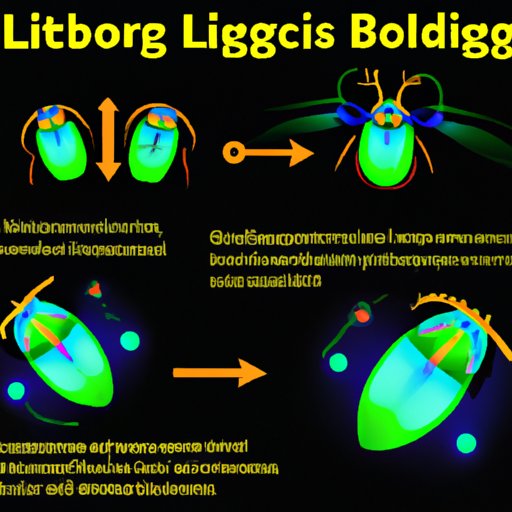Introduction
As children, we were all captivated by the mystical creatures known as lightning bugs or fireflies. The excitement of running around with jars in hand, trying to catch the mesmerizing illuminations left us enchanted. However, as adults, we often find ourselves wondering, why exactly do these bugs light up? The explanation lies within their biology and the chemical reactions that make them glow. This article is written to provide readers with an in-depth understanding of the science that makes these creatures light up and their cultural significance.
The Science Behind Lightning Bugs: Understanding the Chemical Reactions that Make Them Glow
Bioluminescence is the process by which an organism emits light through a chemical reaction. Bioluminescent insects, such as lightning bugs, produce light through a combination of chemicals within their bodies. The light is created through a process called ‘chemiluminescence,’ in which energy is released during a chemical reaction. The bioluminescent protein luciferin and the enzyme luciferase work together to produce this light. The amount and type of light produced depends on the chemical reaction taking place.
Interestingly, bioluminescence has many functions in the natural world, such as attracting mates, scaring off predators, and serving as a means of communication between individuals of the same species.
Unpacking the Mystery of Fireflies: The Biology Behind Their Illuminated Display
Lightning bugs belong to the beetle family Lampyridae and are characterized by their glowing abdomens. Their light is produced through a chemical reaction that occurs inside special cells known as ‘photocytes’ located in their abdomen. Oxygen flows through their body to reach special cells in their abdomen where luciferin and luciferase combine to produce light energy, as well as the waste products carbon dioxide and water. The process is highly efficient, leading to minimal heat production, which is why the bugs remain cool to the touch even when lit up.
The study of bioluminescent organisms is a growing field, and researchers are now investigating ways to harness the power of bioluminescence to create sustainable light sources and other technologies.

The Role of Bioluminescence in Insect Communication: How Lightning Bugs Use Light to Attract Mates
Lightning bugs use light to communicate and attract mates. Female lightning bugs tend to emit stationary light signals, while males will fly and produce varying flashing patterns. The flashing patterns produced by males are specific to each species, and it’s believed that females can differentiate between males based on these patterns.
Using bioluminescence, lightning bugs can synchronise their flashing patterns, creating beautiful, choreographed displays that are captivating to watch. This synchronisation plays a crucial role in ensuring successful mating between the two sexes.
Other insects, such as glow worms, also use bioluminescence for communication, behaving similarly to lightning bugs.
Why Do Some Bugs Glow in the Dark? A Close Look at the Evolution and Adaptation of Bioluminescence
Bioluminescence is widespread among marine, freshwater, and terrestrial organisms. It’s believed that bioluminescence developed independently several times throughout history and has adapted for many ecological purposes in different species. For some deep-sea creatures, it helps illuminate the dark depths they inhabit, while in others, such as lightning bugs, it helps them communicate and attract mates. In some species, bioluminescence functions as a defense mechanism, scaring away predators with sudden flashes of light.
Bioluminescence plays a significant role in the ecology and evolution of a species and can even have significant implications for animal conservation.
The Cultural Significance of Lightning Bugs: How These Bugs Have Shaped Our Folklore and Artistic Imaginations
Lightning bugs have played a role in many cultural stories and folklore. In Japanese folklore, they’re seen as symbols of courage and perseverance, while in other Asian countries, they’re seen as heralds of the summer season. In the United States, it’s common for children to catch these captivating creatures in a jar and keep them as pets. The allure of lightning bugs has also inspired artists, writers, and filmmakers to incorporate them into their works, from children’s books to blockbuster films.
The Future of Bioluminescent Research: Innovative Uses of Lightning Bugs in Medical and Technological Advancements
The unique properties of bioluminescence have attracted many researchers, and the applications of this research are endless. Bioluminescence is being studied to create sustainable light sources, as well as to develop novel medical therapies for various diseases. For example, researchers have developed strains of glowing bacteria that can be used to detect toxins in the environment and to monitor cancer treatments in real-time. Furthermore, bioluminescence has the potential to revolutionize the fields of biotechnology, nanotechnology, and regenerative medicine, among others. The possibilities are endless.
The Role of Human Intervention in Lightning Bug Populations: Conservation Strategies for Preserving These Insects and Their Environments
Human intervention poses a significant threat to the survival of lightning bugs. Habitat destruction and the use of pesticides have put their populations at risk. Fortunately, there are ways to preserve lightning bug populations, such as adopting sustainable agricultural practices and setting aside land conservation areas. Additionally, educating the public about the dangers facing these creatures and the importance of their conservation is crucial. As individuals, we can also do our part by avoiding the use of insecticide and leaving natural habitats untouched.
Conclusion
Lightning bugs have captivated people for centuries, and the magical phenomenon of bioluminescence is just one of the many ways the natural world can surprise and inspire us. Through understanding the biology and science behind lightning bugs, we have gained a deeper appreciation of the role these insects play in the ecosystem. By embracing conservation strategies, we can protect the lightning bugs we love and ultimately, preserve the natural world we take immense pride in understanding.
